The Windows RT Review
by Vivek Gowri & Anand Lal Shimpi on October 25, 2012 12:00 PM EST- Posted in
- Windows RT
- Operating Systems
- Microsoft
- Mobile
- Windows 8
- Tablets
First Party Applications
Microsoft has bundled in a healthy suite of first party applications for Modern UI, including obvious suspects like Internet Explorer, Mail, Calendar, People, Maps, Messaging, and Bing, as well as apps for things like news, finance, sports, weather, remote desktop, and media playback, amongst others.
There’s also a list of desktop applications that’s a little less heartening. The familiar old Windows Accessories are still sticking around, with favorites like Paint and Notepad joined here by the classic Remote Desktop Connection application, Snipping Tool (another holdover from the Windows Tablet PC days), the Math Input Panel, and XPS document viewer. Ease of access applications, too, are desktop-based, as are system functions like Control Panel, Command Prompt, File Explorer, Task Manager, and the Run dialog. Personally, I’m disappointed that there wasn’t a Modern UI version of Command Prompt because, let’s face it, how cool would that be?
You’ll note that I left out the headlining Windows RT application: Office 2013. It’s one of the most vital pieces to the Windows RT puzzle, so it demands a bit more context - I’ll get to it in a bit, after running through some of the more notable first party applications.
The mail application here is decent, with an ultra-spartan design and a straightforward 3-column layout. You get accounts and folders on the far right, a middle column with the sender, subject, and thread information. When you expand a multi-email thread, a message preview is also shown. Finally, in the main part of the window, the selected message is displayed. If you’ve used any recent version of Outlook or Hotmail, the layout and implementation should be instantly familiar except for the Metro visual style. Compose, reply, and delete are located in the top right corner of the email window, while mark as unread and move to folder are located in the bottom edge swipe bar.
As far as options go, there really isn't much to mess with - just the ability to turn off threaded messaging. You can connect any EAS, IMAP, or POP email accounts, with support for Hotmail, Gmail, Exchange, AOL, and Yahoo mail accounts built in already. For Gmail accounts, the delete button actually just archives things - to really delete mails, you need to move the message to the deleted folder.
Mail isn't Outlook, and usability is far from perfect. Manual syncing requires an edge gesture to reveal the sync button and there's no way to just tap on a sender's name and create a new email. There are other little issues like these that keep Mail from being a best in class tablet email client. Mail works, it just isn't great.
Calendar
The calendar application is similarly focused - a very clean user interface with not too much power, but it does exactly what it needs to. It will sync to Hotmail, Google, and Outlook calendars, and I'm hoping that once there is a Facebook application, it will sync to that as well. You can pick between day, week, and monthly resolution from the bottom swipe menu, which is also where you add new calendar events. Options for adding new calendar events include date, time, length, location, repetition and reminders - the standard list. The UI is again very touch-centric, so trying to use the calendar with just the mouse is slightly frustrating since everything is hidden in the edge swipe bar. Thankfully, pressing or clicking on a particular day/time takes you directly to a new event creation page, which is pretty convenient. I like the way the calendar application operates, and the visual style is perfect for getting the information you need at a glance. Power users might find it lacking, but for basic tasks, it's more than adequate.
Messaging
The messaging application is one that has so much potential, but needs more to really be useful unless you only use Live Messenger and Facebook Chat. Personally, given the Skype acquisition and the combining of the Windows and Skype IDs (I’ll get to this later, but basically when you login to Skype, your Windows ID is linked to your Skype ID), I feel like the Messaging app should either include Skype chat in it or somehow fuse Skype with the messaging protocols already in place. I personally rely on Google Talk, and in an ideal world it would be supported as well, but I won’t hold my breath.
Nobody I know has used Live Messenger since it stopped being MSN Messenger, so I reserved most of my testing for Facebook Chat. It’s a good looking chat interface, but using it full-screen is a total waste of display real-estate. Messenger is an application that lives for Windows 8 Snap, and it’s really the perfect app to show off that capability with. Finally, a tablet operating system that’s good for instant messaging.
Bing News, Sports, and Travel
There are a variety of Bing-based applications here - News, Sports, Travel, and of course, Bing itself. I personally don’t find too much point to the Bing search app, since if I’m already in the browser it’s much easier just to search from the URL bar.
The other applications are somewhat interesting though. Sports and News are very similarly designed, so I’ll cover them together. Basically, there’s a top story that takes up most of the front page. You can horizontally scroll through a number of other headlines, aggregated from various news sources (Reuters, NYT, AP, etc) and separated by category - US, World, Technology, Business, etc. You can choose to browse the “Bing Daily” news, news specially targeted towards you, or pick from the list of sources to see each one individually. (My feed was full of technology news, wonder why.) Sports is essentially the same thing, except with the categories being sorted into the various sports. You can pick favorite teams, look at all the day’s sporting news or just the particular sport you want to see.
In either case, the articles are presented in a clean, easy to read format. For a one-stop-shop news source, it’s pretty decent. The overall treatment reminds me a bit of Flipboard a bit, while the articles themselves are displayed in a reading optimized context like Apple’s Reader mode in Safari. The treatment is obviously different - horizontal columns and page scrolling, but it’s a generally similar concept.
Bing Travel is a bit different - it has a list of popular destinations, and features numerous photos, maps, panoramas, list of attractions, hotels, restaurants, and guides for each city page. From the app, you can research the location, book flights and hotels, and use the application to guide your trip plan in terms of sites and restaurants to visit. Most big cities in each geographic region are listed, though smaller travel destinations are a bit harder to come by. I can see the app being really useful when on travel as a more convenient alternative to Yelp.


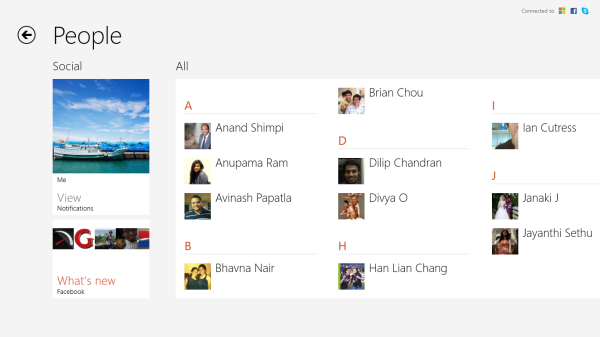

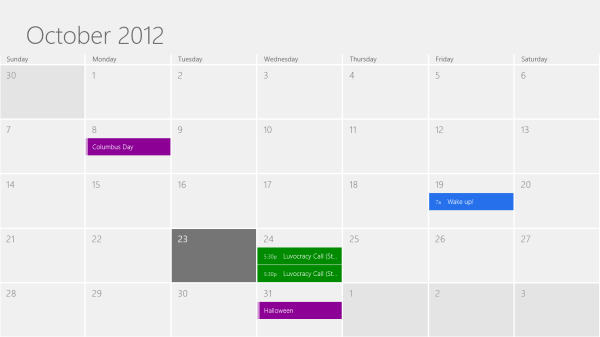
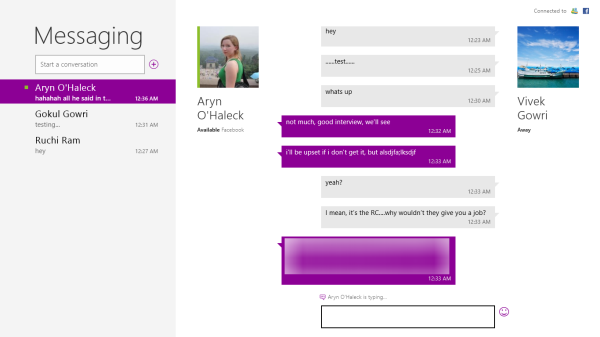

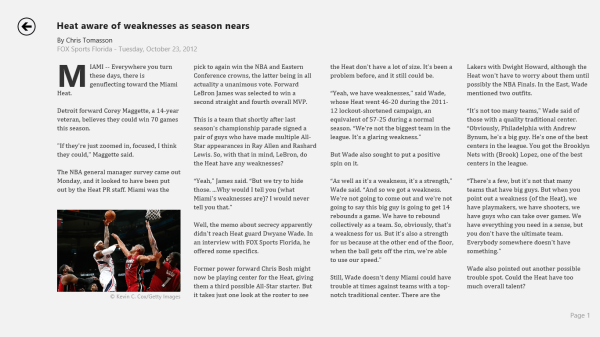
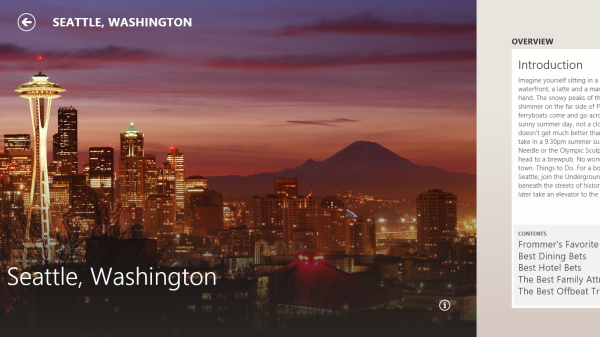








233 Comments
View All Comments
Dorek - Friday, November 2, 2012 - link
AFAIK, task manager tray doesn't even have thumbnails. Come on, it's not comparable to what Windows 8 and Windows RT do. Have you used them?yyrkoon - Sunday, October 28, 2012 - link
The software issue, will not be much of an issue at all.Microsoft will just write another abstraction layer ( HAL ) for ARM. Which is most likely what they've done here.
Passed that. IF any abstraction layers need to be written for the COM model, or .NET libraries. You can rest assured Microsoft will cover that as well. If it hasnt been covered already. Which Im betting it has.
Again, this is nothing like WinCE.This is a real OS, for real end users, with a different HAL.
The biggest issue as I've stated in previous posts. Is not whether it will be easy to write applications for Windows RT. But whether software developers deem it prudent to spend thousands of dollars on Microsoft development tools( not absolutely necessary ). THEN pay Microsoft a forced 30% distribution fee. Through their app store.
For me personally. The 30% fee alone is enough for me to jump ship. And I really enjoy writing apps for Windows. We'll see how it all works out in the end.
karocage - Friday, October 26, 2012 - link
This comment from the article seemed odd to me:"This isn’t like Windows Phone, where we need to see whether the platform will get any market traction before predicting the growth of the app marketplace."
Market traction and app store growth don't seem to have much if any relationship with Windows Phone. WP7 hit 100,000 apps faster than either iOS or Android and has over 125,000 now. If anything, that would seem to indicate that MS really does have a lot of pull with developers independently of market share. So while I agree that the sheer number of devices will be a big draw, I'd argue that's just the cherry on top that guarantees we're going to see a ton of support really quickly for RT/Metro apps.
Obviously buying a WinRT tablet today will be pretty limiting in terms of 3rd party software, but experience from WP7 suggests this will be a very short-lived downside of the platform.
Dorek - Friday, November 2, 2012 - link
Good point. I've been on Windows Phone 7.5 for a year, and have never had the problem of not being able to find an app I want. (With the exception of Pandora, the assholes. Can't even use third-party ones because they block them. But I have a Zune--I mean, Xbox Music Pass anyway. So screw Pandora.)andypost - Friday, October 26, 2012 - link
Anandtech writes the best articles. period.Thanks to Vivek Gowri and Anand Lal Shimpi for a great article.
Visual - Friday, October 26, 2012 - link
You say it is impossible to make desktop apps, but...I read that Win RT still has PowerShell. A lot of PowerShell scripts on x86 just invoke various functions in third-party ActiveX controls, which are just x86 executable binary libraries, and that will not work on RT... but maybe at least the core MS objects still work? For example, if Windows Forms or Windows Presentation Foundation still works, then PowerShell scripts can create desktop windows with various GUI elements.
And since there is an IE, maybe HTA applications work as well?
Do you have some scripting geek working at AT that could test these theories out?
On another topic, I am very surprised you say there are x86 executables on your install. That is just wasted space on a device that doesn't get a large drive to begin with anyway. MS would get in serious trouble if it were true... Are you sure?
And lastly, I am curious if a Win RT device is supposed to be able to get plugged to a "real" Windows computer over USB for charging or for as a mass storage drive, for transfering files... If it is, then coudn't you also plug one RT device to another RT device? Then which one will become the "host", and which one will become the peripheral?
Dorek - Friday, November 2, 2012 - link
"And lastly, I am curious if a Win RT device is supposed to be able to get plugged to a "real" Windows computer over USB for charging or for as a mass storage drive, for transfering files... If it is, then coudn't you also plug one RT device to another RT device? Then which one will become the "host", and which one will become the peripheral?"Dude...that's deep.
(That's actually a really good question. Surface can't be charged over USB, but I don't know about other ARM devices.)
tommo123 - Friday, October 26, 2012 - link
i mean if someone writes an app and gives it away. there's no sideloading so if has to go through the store right?will microsoft host it for free? if not then they're effectively killing off free software for windows are they not? at least win rt which is eventually (how they'd like) desktop windows to go too.
tipoo - Friday, October 26, 2012 - link
Yes they'll host it for free. And there are many free apps already, there was a influx of apps on launch day and most reviews were done before that. They only take a percentage of the cuts from paid apps, nothing from free.Visual - Friday, October 26, 2012 - link
I forgot one question in my previous post.How is the browser performance with many many tabs open at once? Like 20, or even 100?
I sometimes use tabs in a bit weird way, ctrl+clicking possibly interesting links in some large index page to open them in a background tab for later reviewing it in more detail. Even without Flash, with IE9 starting a new process for each tab by default and a few animated gif ads and various JS scripts on each tab, it really kills Atom Netbooks and even CULV Core 2. It's probably more of a memory usage thing than a CPU thing actually... But anyway, how could that go on these new ARM devices?